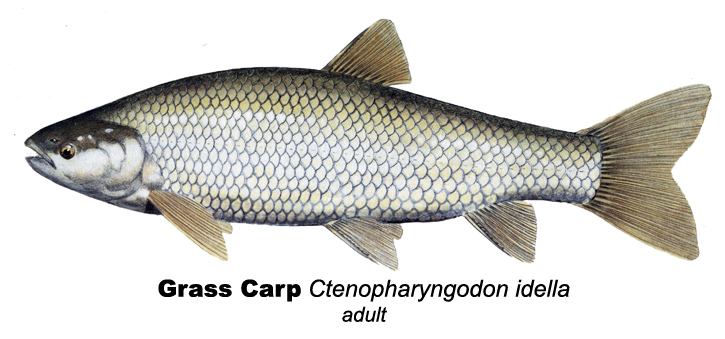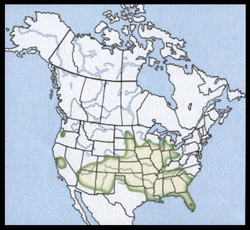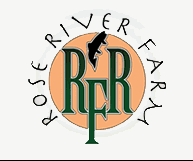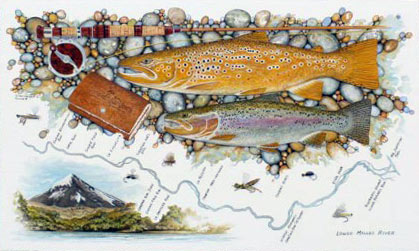Grass Carp, August 2013, Fish of the Month!
A Brief Note to Our Readers:
Arranged in taxonomic (scientific) order, this column has, with this entry, passed out of the realm of our fly rod glamour species, the Trouts and Salmons (and even the Pikes), and into a broader realm of generally warm water-loving species. To this end, we’ll jump into these habitats and species with both feet and begin with the Minnows.
“Minnows?!?” we can hear you exclaiming. Yes, minnows. “You mean there are 30 pound minnows?!?” Yup, there are and we’re going to lead into all this with two of them.
 Grass Carp (White amur)
Grass Carp (White amur)
Ctenopharyngodon idella
Local Names:
Grass Carp
Average Size:
20 to 30 inches to as much as 50 inches
5 to 10 pounds to as much as 50 to 60 pounds
Distinguishing Field Marks:
Color and color pattern are reliable distinguishing field marks for this species. (See the illustration.)
-
This species is broad across the back and is often quite deep-bodied.
-
Grass carp have rather small heads for their size and girth. The mouth is small and terminal, at the forward tip of the head.
-
The upper jaw is short, extending only to the center line of the eye.

-
The scales are moderately large.
The caudal fin is noticeably large and moderately forked.
North American Range:
Map to the right shows approximate range in North America.
Biology:
This exotic Asian species was introduced into North America in the state of Alabama in 1963 by the U.S. Fish & Wildlife Service through the Fish Farming Experimental Station, and Auburn University. Its intended use was the control of vegetation at commercial fish farming operations. There have been several incidences of fertile Grass carp escaping from captivity and beginning sustaining wild populations, especially in the lower Mississippi River Valley. At this point, it has been recently reported that as much as 50% of the biomass of the Mississippi River consists of 3 exotic species; Grass carp, Silver carp, and Bighead carp. That represents a major North American river system heavily out of balance.
In the wild, fertile Grass carp are summer spawners, usually from June into August. As with the Common carp, the eggs and sperm of sexually mature Grass carp are simultaneously released and broadcast as pods of fish swim near the surface over dense vegetation. Fishing for either of these species during their spawning seasons will usually result in frustration because, although they are very easy to locate at this time, and are often found in large groups of individuals, they'll remain narrowly focused on their spawning activity.
Most Grass carp now being raised as aids to fish farmers are of the "triploid" form, produced by either temperature or pressure shocking the fertilized eggs, resulting in sterile offspring. This is the case because it has been realized that Grass carp can have serious negative impacts on North American native species, so further introductions of fertile fish are no longer allowed.
Diet:
The very young feed on small aquatic invertebrates and then later turn nearly exclusively to soft stemmed vegetation and filamentous algae with the occasional insect or mature berries that happen to fall into the water.
Fly Fishing for Grass Carp
An internet search for the species will provide as much local range information as necessary.
Grass carp are vegetarians and will not be enticed by the traditional "gob of night-crawlers," nor will they be particularly aggressive toward any angler's offerings. Second, blind casting is likely to be much less productive than "sight fishing." Grass carp spend much of their time cruising leisurely about searching for food, or simply "basking" at the water's surface. So, patiently waiting in or near the Grass carp's preferred habitats or taking a shore-line search walk will save a lot of casting energy, frustration, and will allow you the opportunity to study all that is going on on the water.
Fly fishers have recently begun to explore the world of carp fishing and are finding it interesting and exciting. Grass carp are generally better fly rod fish than they are spinning or casting rod targets because they often take light-weight foods well above the bottom.
Fly rods for these large powerful fish should be in the 8- to 9- weight class with reels loaded with floating lines with long leaders.
Fly fishers interested in targeting Grass carp are on the cutting edge of the sport and will find acute observation and experimentation the order of the day. Like their cousins, the Common carp, Grass carp are more easily taken when they have been "chummed" into a feeding mood. When you have located a group of cruising Grass carp, carefully toss any type of bread toward them. They will take those floating bread scraps and your floating flies in much the same way as a trout will casually take a dry fly. You can on occasion take these fish on a fly without first stirring their feeding instincts, but this method is typically much less productive than the previous way of pre-feeding them. In addition to this fish's large average size, its shyness, and, you might say "selectivity," it will often jump when hooked.
There are continually being developed fly patterns for carp. Because the field is so new, we'll here again refer you to the world-wide-web as your best source of effective Grass carp flies.
There are certainly those among us who wouldn't even consider carp fishing with a fly rod. But, for those of us who do, a whole world of readily available, big fish freshwater fly rodding for some of this world's most intelligent fish opens up, often only a very short distance from the angler's home.
Significance to Humans:
Primarily as a commercial species introduced to the U.S. to control weeds in fish farms. The Grass carp has only recently been of much interest to anglers.
Status:
Thriving (to the severe detriment of native species) in favorable habitats.
Grass carp can withstand a very wide range of water temperatures and so have a parallel wide range of favorable habitats. We should expect to see this species expanding its North American range. All three exotic Asian carp species in the Mississippi River drainage are on the doorstep of the Great Lakes and carry with them the potential to destroy the bottom of the food web in those already highly stressed waters. For this reason, much attention is being paid to the interface between the Mississippi River and Lake Michigan watersheds in an attempt to keep these exotics (especially the Silver and Bighead carp) out of the Great Lakes.






